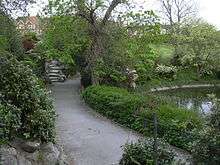Queen's Park, Brighton

Queen's Park is an administrative ward and a public park in Brighton, England. The population of the ward at the 2011 census was 15,904.[1]
The area lies to the east of the centre of Brighton, north of Kemptown and south-east of Hanover. It is largely made up of Victorian terraced houses, with a smaller number of detached and semi-detached houses. There are also a number of low-rise blocks of modern flats.
In 1825, Thomas Attree, a property owner and developer in Brighton, acquired land north of Eastern Road—already known as Brighton Park—to build a residential park surrounded by detached villas, inspired by Regent's Park in London. He commissioned architect Charles Galloway to design it. Thomas renamed it after Queen Adelaide, consort of William IV. Queen Adelaide patronised the German Spa opened in 1825 by Dr F A A Struve of Dresden at the south end of the park, which remained in operation until 1886 when it continued as a mineral water plant until 1960. On the site now stands the Royal Spa Nursery school. Thomas' plan never fully materialised and the surrounding housing is mostly late Victorian with some late 20th century infill and replacement.
At the north-west corner is Pennant Lodge, once the home of Charles Freshfield. Also to the north-west of the park itself, on Queen's Park Road, stands the Pepper Pot (also called the "Pepper Box"). Probably originally built as a horizontal wind-powered water pump, and later used for the publishing of a local newspaper, it was later an artist's studio and by the 1990s a public convenience. In the 21st century it has been sealed and unused.[2][3] The park itself, without the houses but including the Spa and the Pepper pot, was bought by the Race Stand Trustees in 1890 for £13,500 and donated to the town.[2]
Today Queen's Park is an attractive public park, well planted with trees and shrubs. It has a large pond, frequented by ducks, geese and herring gulls. Along with a children's play area, a café, an extensive dog-free area, a scented garden for people with disabilities, a bowling green, tennis courts, and an area that is left untended in order to encourage wildlife.
St Luke's Church, an Anglican church built in the Early English style, serves the area. Designed by Sir Arthur Blomfield and constructed between 1881 and 1885,[2] the large flint-walled building has an unusual layout of bays in the north and south aisles of its nave;[4] Nikolaus Pevsner described this as "curious" and a "disturbing motif".[5] The church was listed at Grade II in 1999.[4]
References
- ↑ "Brighton and Hove Ward population 2011". Retrieved 13 October 2015.
- 1 2 3 Carder, Timothy (1990). "Queen's Park". The Encyclopaedia of Brighton. Lewes: East Sussex County Libraries. p. §138.
- ↑ Multiple authors (2009). The story of Queen's Park Brighton. Brighton: Brighton Town Press.
- 1 2 "Images of England — detailed record, Church of St Luke, Queen's Park Terrace (north east side), Brighton". Images of England. English Heritage. 2007. Retrieved 2008-11-04.
- ↑ Nairn, Ian; Pevsner, Nikolaus (1965). The Buildings of England: Sussex. Harmondsworth: Penguin Books. p. 433. ISBN 0-14-071028-0.
External links
- Parks link on council site
- History and personal recollections on My Brighton and Hove site
Coordinates: 50°49′29″N 00°07′32″W / 50.82472°N 0.12556°W